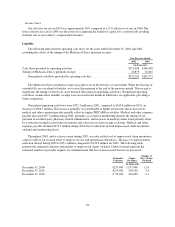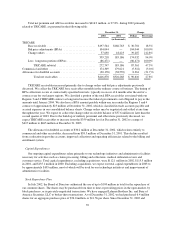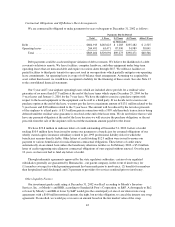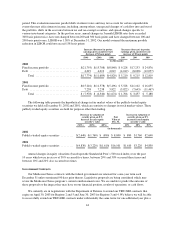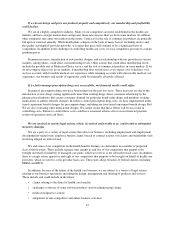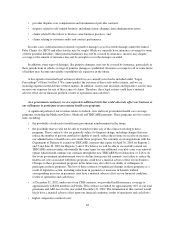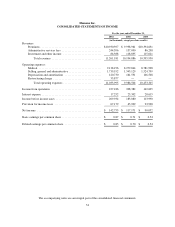Humana 2002 Annual Report Download - page 53
Download and view the complete annual report
Please find page 53 of the 2002 Humana annual report below. You can navigate through the pages in the report by either clicking on the pages listed below, or by using the keyword search tool below to find specific information within the annual report.If we do not design and price our products properly and competitively, our membership and profitability
could decline.
We are in a highly competitive industry. Many of our competitors are more established in the health care
industry and have a larger market share and greater financial resources than we do in some markets. In addition,
other companies may enter our markets in the future. Contracts for the sale of commercial products are generally
bid upon or renewed annually. While health plans compete on the basis of many factors, including service and
the quality and depth of provider networks, we expect that price will continue to be a significant basis of
competition. In addition to the challenge of controlling health care costs, we face competitive pressure to contain
premium prices.
Premium increases, introduction of new product designs, and our relationship with our providers in various
markets, among others, could affect our membership levels. Other actions that could affect membership levels
include the possible exit of Medicare+Choice service and the exit of commercial products in some markets. If we
do not compete effectively in our markets, if membership does not increase as we expect, or if it declines, or if
we lose accounts with favorable medical cost experience while retaining accounts with unfavorable medical cost
experience, our business and results of operations could be materially adversely affected.
If we fail to manage prescription drug costs successfully, our financial results could suffer.
In general, prescription drug costs have been rising over the past few years. These increases are due to the
introduction of new drugs costing significantly more than existing drugs, direct consumer advertising by the
pharmaceutical industry that creates consumer demand for particular brand-name drugs, and members seeking
medications to address lifestyle changes. In order to control prescription drug costs, we have implemented multi-
tiered copayment benefit designs for prescription drugs, including our four-tiered copayment benefit design, Rx4.
We are also evaluating other multi-tiered designs. We cannot assure that these efforts will be successful in
controlling costs. Failure to control these costs could have a material adverse effect on our financial position,
results of operations and cash flows.
We are involved in various legal actions, which, if resolved unfavorably to us, could result in substantial
monetary damages.
We are a party to a variety of legal actions that affect our business, including employment and employment
discrimination-related suits, employee benefit claims, breach of contract actions, tort claims and shareholder suits
involving alleged securities fraud.
We and some of our competitors in the health benefits business are defendants in a number of purported
class action lawsuits. These include separate suits against us and five of our competitors that purport to be
brought on behalf of members of managed care plans, which we refer to as the subscriber track cases. In addition,
there is a single action against us and eight of our competitors that purports to be brought on behalf of health care
providers, which we refer to as the provider track case. These suits allege breaches of federal statutes, including
ERISA and RICO.
In addition, because of the nature of the health care business, we are subject to a variety of legal actions
relating to our business operations, including the design, management and offering of products and services.
These include and could include in the future:
• claims relating to the denial of health care benefits;
• challenges to the use of some software products used in administering claims;
• medical malpractice actions;
• allegations of anti-competitive and unfair business activities;
47



